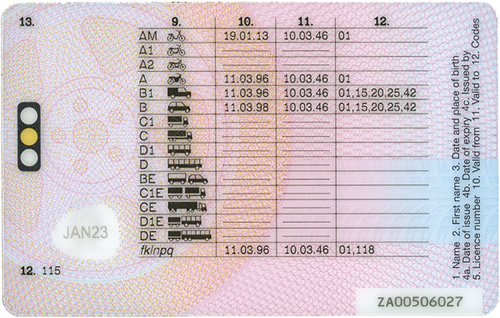What licence do I need to drive a motorhome or campervan?
Published:
Here in the UK, the licence you'll need to drive a motorhome or campervan depends on your age and the vehicle’s maximum authorised mass (MAM).
The good news is, if you have a standard driving licence (Category B) you can already drive a motorhome or campervan weighing 3,500kg or under, and as you can see in the table below, many Swift vehicles fit within this bracket.
If you wish to drive a vehicle between 3,500 and 7,500kg (MAM) then you'll need a Category C1 licence. Some of our larger motorhomes sit in this bracket, so check the back of your driving licence to establish what you are entitled to drive. In the example licence image below, you can see it details the valid ‘to and from’ date against the category you can drive.

If you hold a full UK car driving licence and passed your driving test before 1 January 1997 then you may be able to drive medium sized vehicles.
If you hold a full UK car driving licence, are over 18 and passed your driving test on or after 1 January 1997 then you can apply for a provisional medium-sized vehicle entitlement.
To attain the C1 licence you are required to take a theory and practical test, and a medical assessment is generally required. The cost will ultimately depend on how many practical lessons you take.
You can read more on the various licence categories at gov.uk. Please note that licence categories are different in Northern Ireland.

"A standard driving licence (for those that may not know, a Category B) allows you to drive the majority of Swift motorhomes and campervans, as they sit within the 3500kg weight bracket. Take a read of our guide on which Swift vehicles are under 3500kg."
Jo Mitchell, Marketing Director at Swift
Swift vehicle reference
The table below shows which licence you need to be able to drive each of the 2024 Swift motorhomes and campervans.
| Model | Weight (kg) | Licence required to drive |
|---|---|---|
| Swift Monza | 3190kg | Car (category B) |
| Swift Carrera | 3500kg | Car (category B) |
| Swift Ascari | 3500kg | Car (category B) |
| Swift Trekker | 3500kg | Car (category B) |
| Swift Voyager | 3500kg | Car (category B) |
| Swift Escape (640) | 3500kg | Car (category B) |
| Swift Escape (674 / 684* / 694) | 3700kg - 4500kg | Category C1 |
| Swift Kon-Tiki | 4500kg - 5000kg | Category C1 |
* From 2024, the Escape 684 is plated at 3700kg, models prior to 2024 please refer to your owner’s technical handbook.
Weights explained
The unladen weight of any vehicle is the weight of the vehicle when it’s not carrying any passengers, goods or other items. It includes the body and all parts normally used with the vehicle or trailer when it’s used on a road. It doesn’t include the weight of the fuel or, if it’s an electric vehicle, the batteries.
Mass in Running Order is the mass of the unladen vehicle including a 75kg allowance for the driver plus 90% of the fuel tank and an 10kg allowance for LPG. The Swift MROs are calculated with the fresh water tank empty. If you travel with water in the fresh water tank then the payload will reduce accordingly.
Maximum authorised mass (MAM) or Maximum Technical Permissible Mass (MTPLM) (which you will find in your owner’s technical handbook) is the weight of a vehicle including the maximum load that can be carried safely when it’s being used on the road. This is also known as Gross Vehicle Weight (GVW).
Summary
In summary, before investing in a new motorhome or campervan, it's important to qualify what vehicle category you can drive. Check the back of your current driving licence card to ensure you have the relevant category as you may need to apply for a higher entitlement.